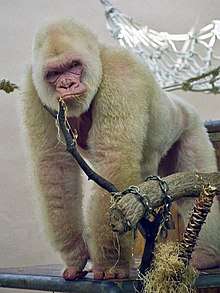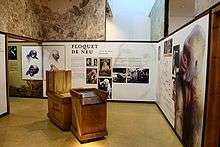Snowflake (gorilla)
Snowflake (Catalan: Floquet de Neu, Spanish: Copito de Nieve, French: Flocon de Neige; c. 1964 – 24 November 2003) was an albino western lowland gorilla. He was kept at Barcelona Zoo in Barcelona, Catalonia, Spain, from 1966 until his death.[1][2]
 Snowflake | |
| Species | Western lowland gorilla |
|---|---|
| Sex | Male |
| Born | c. 1964 Spanish Guinea |
| Died | November 24, 2003 (aged 38–39) Barcelona Zoo, Barcelona, Catalonia, Spain |
| Years active | 1966–2003 |
| Known for | Being the world's only known albino gorilla |
History
Snowflake was captured in the Río Muni region in Spanish Guinea on 1 October 1966 by ethnic Fang farmer Benito Mañé. Mañé had killed the rest of Snowflake's gorilla group (who were normal in colour). Mañé then kept Snowflake at his home for four days before transporting him to Bata, where he was purchased by primatologist Jordi Sabater Pi.[3]
Originally named "Nfumu Ngui" in Fang language ("white gorilla") by his captor, he was then nicknamed "Copito de nieve" (Spanish for "little snowflake"[4]) by his keeper Jordi Sabater Pi.[5][6]
Characteristics
Snowflake was a western lowland gorilla with non-syndromic oculocutaneous albinism.[7][8][9] He had poor vision, though tests to determine whether he had a central blind spot did not find one.[10] Barcelona Zoo director Antonio Jonch wrote:
"The eye had a blueish sclera, a normal cornea, and a light blue iris which was very transparent to transillumination. Accommodation and refraction were normal. The media were transparent and the fundus of the eye normal and totally depigmented. The choroidal vessels were perfectly visible and the pupil was normal. The animal displayed marked photophobia which caused it to close its eyes repeatedly when exposed to bright light. In diffuse light similar to that in its biotope, we calculated that it blinked on an average of 20 times a minute."[9]
Study of Snowflake's genome determined that his parents had 12% of their DNA in common, leading researchers to believe that his parents were uncle and niece. The same study revealed that his albinism was caused by a mutation of SLC45A2 gene. Snowflake received the recessive gene from both parents, causing his albinism.[7][11]
Life in Barcelona

Upon his arrival to Barcelona in November 1966, he was given an official reception by the then Mayor of Barcelona, Josep Maria de Porcioles and called "Blancanieves" ("Snow White") in the newspaper Tele/Exprés.[12] But he became famous with the name given to him by Sabater when National Geographic Magazine featured him on the cover in March 1967, with the English name Snowflake. This name spread among the press (Stern, Life, Paris-Match). Sabater himself called the gorilla "Copi" or "Floquet", and in the later years "Nfumu". He was also known as "Little Buttercup",[13] and as the "Vanilla Gorilla".
At first, the Barcelona Zoo was not aware that Snowflake was a unique specimen. They sent a message to Sabater Pi saying, "Please send more white gorillas." The zoo later hoped to produce a genetic strain and an entire family group of white gorillas through selective breeding. The Barcelona Zoo had a protocol in place to have Snowflake's testicles harvested, upon his death, and placed in the frozen zoo so as to reserve the option of having more offspring from him in the future. Snowflake's genes would have been considered particularly valuable because he was wild caught, and therefore one of the genetic founders to the captive population of western lowland gorillas, which are endangered, and are being managed by AZA SSP/EEP captive breeding programs for wildlife conservation.
In 1986 the Barcelona Zoo enlisted British zoo veterinarian David Taylor to collect sperm from Snowflake for artificial insemination. Although the attempt was unsuccessful, the story was carried by newspapers the world over.[14]
Offspring
Snowflake fathered twenty-two offspring by three different mates, or "dams". Six of his offspring survived to adulthood.[15] None of Snowflake's offspring were albino, but all should be heterozygous, recessive carriers, for the albino gene. Half of his grandchildren likely carry the albino gene. If both parents were albino gene carriers they have 25% chance of producing an albino offspring.
As of May 2014, Snowflake had a total of 21 grandchildren (11 survived) and four great-grandchildren (all living).[16] Snowflake's great-grandson N'Kou has pink fingers which is perhaps suggestive of partial albinism.
Death
In 2001, Snowflake was diagnosed with an unusual form of skin cancer, almost certainly related to his albinism.[17] By 2003, Snowflake's health began to deteriorate. After he began losing interest in his usual activities, isolating himself from other gorillas and exhibiting signs of pain, Snowflake's keepers decided to euthanize him.[18] The decision was publicly announced in September 2003.[15] Thousands of people visited Snowflake at the Barcelona Zoo before he was euthanized on 24 November 2003. At the time of his death, Snowflake was thought to be between 38 and 40 years old.[15][19]
Legacy
- The asteroid 95962 Copito, discovered by Spanish astronomer J. Manteca, is named in his honour.[20]
 A room dedicated to Snowflake
A room dedicated to Snowflake - A scholarship for research on primatology was created in memory of and homage to Snowflake. Snowflake's fame also helped to promote awareness of the endangered gorilla species.[18]
- An illustration and brief description of Snowflake (as to 1969) appears in the Italian children nonfiction book series Guarda e Scopri Gli Animali.[21]
- The gorilla became a main character in the novel Memòries d'en Floquet de Neu ("Snowflake's Memories") by Catalan writer Toni Sala.
- Sabater Pi also dedicated a book to the gorilla, under the title Copito para Siempre (Snowflake Forever).
- He also makes a brief appearance in Italo Calvino's novel Mr. Palomar – the passage is a meditation on loneliness, captivity, the burden of being unique in the world, and mortality.
- Nature on PBS devoted an episode to him.
- Former U.S. Poet Laureate Billy Collins wrote of Snowflake in his poem, "Searching," published in his 2008 collection, Ballistics.[22]
- Snowflake appears on the front cover of dance music act Basement Jaxx's album Rooty.
- While playing at FC Barcelona, Dutch football player Ronald Koeman was nicknamed Copito de Nieve because of his blond hair.
- Snowflake appeared on The Triplets (Les Tres Bessones) episode "The Triplets meet King Kong" as a guest of honor for the appearance of King Kong in Barcelona's Olympic Stadium.
- In 2009 French musician Enzo Enzo released the album Toutim where the song Copito De Nieve De Barcelone is dedicated to Snowflake.[23]
- In 2011, there was a live action/CGI film called Snowflake, the White Gorilla that depicts the fictional childhood of Snowflake (voiced by Ariana Grande).
Albino gorillas in other media
Other albino (or white-furred) gorillas similar in appearance to Snowflake have appeared in different media appearances.
- Prior to the birth of Snowflake, the film Son of Kong featured King Kong's son who was an albino gorilla that was twice the height of a human and was named "Little Kong".
- In Legends of Chima, the Gorilla Tribe member Grizzam has white fur similar to Snowflake.
- A white-furred gorilla appears in the French superhero comic series Photonik (featuring in "African Devil"; Volume 1, Mustang #66, 1981)[24], serving as the totem for an evil shaman who wishes to rule all of Africa. As was the case with Snowflake, his entire group is killed by an unscrupulous poacher, and the white gorilla sold into captivity.
- In The Flash, Solovar was depicted as an albino gorilla.
- In the 2017 film War for the Planet of the Apes, an albino gorilla named Winter (voiced and motion-captured by Aleks Paunovic) appears in Caesar's tribe and defected to the Colonel's side out of fear.
- In the 2018 film Rampage (which is based on the video game series of the same name), George (motion-captured by Jason Liles) is albino in the movie adaptation to differentiate from King Kong as Dwayne Johnson says George is based on Snowflake.
References
- "Albino animals: from Snowflake the white gorilla to White Diamond the alligator". telegraph.co.uk. Archived from the original on October 26, 2014. Retrieved October 25, 2014.
- Sorokanich, Lara (June 18, 2013). "Albino Gorilla Was Result of Inbreeding". nationalgeographic.com. Archived from the original on July 9, 2014. Retrieved October 25, 2014.
- Riopelle, A.J., "Snowflake the world's first white gorilla", National Geographic 131: 442–8, March 1967
- "The Name Is Snowflake", The Pittsburgh Post Gazette, May 28, 1967
- Sabater's pictures Archived 2009-08-04 at the Wayback Machine, at the Sabater Pi Collection at the Universitat de Barcelona
- "Little Snowflake, World's First White Gorilla", The Palm Beach Post, February 22, 1967
- Javier Prado-Martinez; Irene Hernando-Herraez; Belen Lorente-Galdos; Marc Dabad; Oscar Ramirez; Carlos Baeza-Delgado; Carlos Morcillo-Suarez; Can Alkan; Fereydoun Hormozdiari; Emanuele Raineri; Jordi Estellé; Marcos Fernandez-Callejo; Mònica Valles; Lars Ritscher; Torsten Schöneberg; Elisa de la Calle-Mustienes; Sònia Casillas; Raquel Rubio-Acero; Marta Melé; Johannes Engelken; Mario Caceres; Jose Luis Gomez-Skarmeta9; Marta Gut; Jaume Bertranpetit; Ivo G Gut; Teresa Abello; Evan E Eichler; Ismael Mingarro; Carles Lalueza-Fox; Arcadi Navarro; Tomas Marques-Bonet (May 31, 2013). "The genome sequencing of an albino western lowland gorilla reveals inbreeding in the wild". BMC Genomics. 14: 363. doi:10.1186/1471-2164-14-363. PMC 3673836. PMID 23721540. Archived from the original on October 6, 2014. Retrieved June 4, 2014.
- International Wildlife Encyclopedia Vol. 20, Marshall Cavendish Corporation/New York, 1970, pg. 2710
- Duplaix-Hall, Nicole; Antonio Jonch (1967). "The White Gorilla (Gorilla g. gorilla) At Barcelona Zoo". International Zoo Yearbook. Vol. XIII. London: Zoological Society of London. p. 196. OCLC 604039131.
- Riopelle, A.J., "Growing up with Snowflake", National Geographic, 138:490–503, October 1970
- Pappas, Stephanie (June 17, 2013). "Albino Gorilla 'Snowflake' Was Inbred, Gene Sequence Shows". The Huffington Post. Archived from the original on June 6, 2014. Retrieved June 6, 2014.
- anuaris.cat Archived 2008-10-14 at the Wayback Machine
- Taylor, Henry J., "An Animal Lover: Elephant Is Real King Of Jungle", Ocala Star-Banner, July 28, 1967, page 4
- Taylor, David, Vet on the Wild Side: Further Adventures of a Wildlife Vet, Arrow (Random Century Group), 1991
- "Meet Snowflake The World's Only Known Albino Gorilla". thenigertimes.com. November 29, 2003. Archived from the original on March 16, 2015. Retrieved October 25, 2014.
- Davis, James R. (June 1, 2014). "0281 – SNOWFLAKE". Dewar Wildlife. Dewar Wildlife Trust, Inc. Archived from the original on June 6, 2014. Retrieved June 6, 2014.
- Staff writers (September 22, 2003). "Albino gorilla dying of skin cancer". BBC News. Archived from the original on June 7, 2004. Retrieved June 1, 2013.
- "Snowflake: The White Gorilla". pbs.org. Archived from the original on October 26, 2014. Retrieved October 25, 2014.
- "Zoo Has Euthanized Ailing Albino Gorilla". latimes.com. November 25, 2003. Archived from the original on December 11, 2014. Retrieved October 25, 2014.
- "Asteroide Copito de Nieve" Archived 2007-03-17 at the Wayback Machine
- Mario Faustinelli and Rinaldo D. D'Ami: Guarda e Scopri Gli Animali Volume 11: Dell'Africa. AMZ, Milano 1969.
- Collins, Billy (October 2008). "Poetry: Billy Collins, 'Searching'". theatlantic.com. Archived from the original on October 26, 2014. Retrieved October 25, 2014.
- "Enzo Enzo, Toutim (best of)". Archived from the original on 2016-03-04.
- Cool French Comics: Photonik. Retrieved July 20, 2018.
Further reading
- Riopelle, A.J., "Snowflake the world's first white gorilla", National Geographic 131:442-8, March 1967
- "Unique in all gorilladom: Roman Luera Carbo's Snowflake", Life 62:69–70, March 31, 1967
- Riopelle, A.J., "Growing up with Snowflake", National Geographic 138:490–503, October 1970
- Jonch, Antonio, "The White Gorilla (Gorilla g. gorilla) At Barcelona Zoo", International Zoo Yearbook Vol. XIII, 1967, pg. 196
- Schmeck, Harold M. Jr., "First Known White Gorilla Is Found", The New York Times F. 23 pgs. 1:5 & 41:2
- "Rare albino gorilla dies", The Montreal Gazette, November 25, 2003, pg. A.21
- Gerritsen, Vivienne Baillie (August 2004) "Snowy stardom". Protein Spotlight (SIB Swiss Institute of Bioinformatics).
- https://www.pbs.org/wnet/nature/snowflake Nature episode: "Snowflake: The White Gorilla" at PBS.org